Liposuction (Fat Removal & Liposculpture)
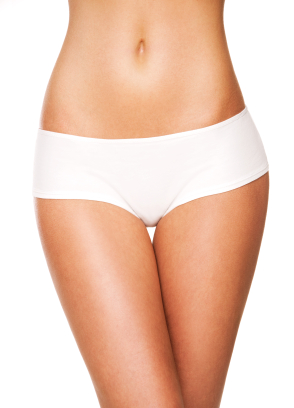
Liposuction or Liposculpture is the removal of excess fatty tissue to reshape the body. Liposuction (Liposculpture) can enhance your appearance and self-confidence. It is not a substitute for weight reduction, but a method for removing area of localised fatty tissue that does not respond to diet or exercise. Liposuction can therefore change shape, not weight.
What is Liposuction/Liposculpture?
Liposuction, also known as liposculpture or suction assisted lipectomy, is a technique to remove unwanted fat. The unsightly distribution of body fat is usually due to an inborn tendency for fat to accumulate in one particular area. It is important to understand that liposuction is not a treatment for obesity.
The Surgery
Liposuction is performed under a general anaesthetic (you are asleep) using a hollow metal surgical instrument known as a cannula that is inserted through small skin incision (s). The cannula is attached to a vacuum source, which provides the suction needed to remove the fatty tissue. In certain situations, the cannula can be simply attached to a syringe to create the required vacuum suction.
Recovery
The liposuction (Liposculpture) surgery is performed as a day case or as 1 night stay depending on the extent of liposuction. There will be stitches that need to be removed a week to 10 days after surgery. A pressure garment support will be required, straight after the surgery, to be worn day and night for approximately 6 weeks. The support can be taken off to wash or bathe, quickly dried and put back on. You are advised to refrain from any heavy duties or strenuous exercises for 6 weeks.
Potential Risks
Every surgical procedure carries a certain amount of risk, and it is important that you understand the risks involved with liposuction (Liposculpture).
You can expect bruising for few weeks and a certain degree of discomfort. Some people bruise more easily than others. The swelling and lumpiness can last for few months.
As swelling can take a long time to settle. You may not see the full benefit of the operation for up to six months. You can expect some numbness in the treated skin.
You will have small scars (key hole) 1.0 to 2.0 centimetres long at the sight of insertion of the suction cannulae. The scars tend to heal very well with very little evidence. However, in a small number of patients, there is a risk that these scars may stay red.
Under or over removal of fat are potential risks that may require further revisional surgery. Some irregularities (unevenness) in the treated area may occur.
Dimples and wrinkles of the skin, sometimes, called cellulite is unlikely to be improved by liposuction.
Bleeding, infection, excessive scarring, blood clots in leg veins and/or lung and further revisional surgery are general risks that can follow any operation.
(1).jpg)
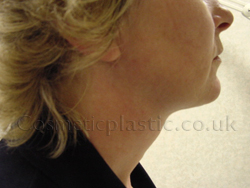
Liposuction Neck: Left (before), Right(after)
|
Before
|
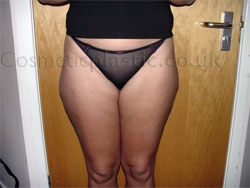
|
|
After 1
|
After 2
|
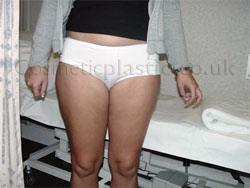
|
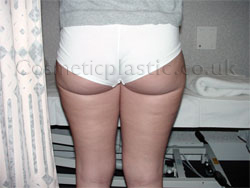
|
Liposuction/Liposculpture (Outer Thighs)
The information provided gives you a basic understanding of the liposuction procedure but it may not answer all your questions, a lot depends on your individual circumstances. This website provides guidance and is not intended to be a substitute for a surgical consultation with Mr Fahmy in Shropshire, Chester, Cheshire or Wrexham, North Wales and Mid Wales.
For any enquiries, you can email Professor Fahmy on info@cosmeticplastic.co.uk . Your consultation will be directly with Professor Fahmy and the treatment will be performed by himself at the hospital of your choice either Pulford Medical Centre, Chester (Cheshire) or Spire Yale Hospital, Abergele & Wrexham (Wales). It is always advisable to bring a friend or a relative during your consultation, as it may further assist you in any questions you may have.
Notice of Copyright ©: 01 July 2008 - The documents and images on this website have been created by Prof. F Fahmy (author), who reserves all rights to their use for purpose of publication, sale, commercial gain, or promotion. Permission must be sought to download, reproduce, copy, print, or otherwise transform any of the documents or images on this website. The copyright for all pictures remains with Prof. F Fahmy.